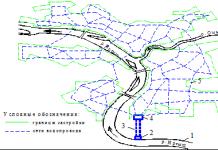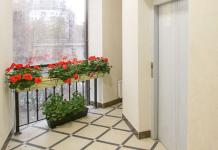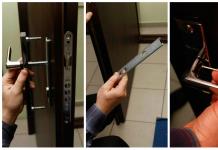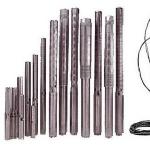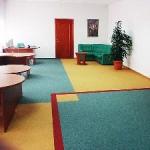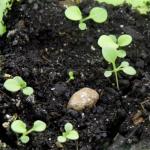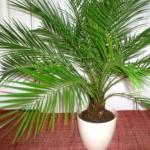When the cold season comes, in most modern apartments there is a problem associated with the temperature of the flooring. Linoleum does not allow you to move around the room without slippers.
Of course, you can avoid this problem by buying natural carpet or installing underfloor heating, but not every family can afford it.
In addition, it is quite difficult to purchase a carpet that completely matches the size of the room. Therefore, in such cases, one of the best solutions is carpet.
The carpet consists of several layers: it is a pile, a primary lining (base) and a secondary lining, which includes a fixing layer and a latex lining.
Carpet is divided into several types, depending on what yarn was used in its production. In the manufacture of carpet, either natural or synthetic thread is used. Among natural materials, the most common are woolen and mixed materials, including from 10 to 30% wool.
The cost of natural wool carpet is higher, although its wear resistance is very low. Its advantages are good elasticity, low level of moisture permeability and flammability. In order to distinguish an artificial carpet from a natural one, you need to set fire to its thread: a woolen thread will smolder, and an artificial one will melt.
Nylon carpet
 The main synthetic materials used in carpet production are polyamide (nylon), polypropylene (olefin), polyacryl and polyester. Nylon carpet is the best to use, as it is softer, does not fade in the sun, and its pile does not wrinkle as much as other types of this material, and there are almost no dents left on it from furniture.
The main synthetic materials used in carpet production are polyamide (nylon), polypropylene (olefin), polyacryl and polyester. Nylon carpet is the best to use, as it is softer, does not fade in the sun, and its pile does not wrinkle as much as other types of this material, and there are almost no dents left on it from furniture.
Cleaning this carpet is very easy. Service life of a carpet from nylon of 10-15 years.
If nylon carpet seems too expensive for you, you can look into acrylic and polyester material. However, polyester will last you no more than 5-8 years, and not everyone will like its rigidity and synthetic sheen.
Olefin carpet
Currently, the most common in the Russian market is olefin carpet, the service life of which is also equal to 5-8 years. However, this material no longer meets modern requirements, the main quality of such a carpet is cheapness.
Carpet from terklon and supreme
 The newest type of carpet is the material of therclone and supreme, which are polypropylene fibers that have undergone chemical and heat treatment in order to improve the level of wear resistance.
The newest type of carpet is the material of therclone and supreme, which are polypropylene fibers that have undergone chemical and heat treatment in order to improve the level of wear resistance.
Such a carpet is very soft to the touch and also looks like a material made from woolen threads.
There are three types of carpet production: woven, tufted, when the base is stitched with pile threads, and needle-punched, in which pile threads are driven into the primary base with needles.
Woven carpet
Woven carpet is the most expensive, as its production does not differ from the production of ordinary carpets. This material is called "natural jute" carpet. The basis of such a carpet has the form of a mesh.
Production of tufted carpet
In the production of tufted carpet, the thread is injected into the base with a needle, and then fixed with an adhesive. Tufting technology is especially popular, as it allows you to create various carpets: looped, when there are loops on top, pile - on top of the piles - and their types.
Loop carpet
 The base of the looped carpet, as a rule, is very rigid, and the loops give it rigidity on the front surface, which gives the material high wear resistance.
The base of the looped carpet, as a rule, is very rigid, and the loops give it rigidity on the front surface, which gives the material high wear resistance.
In the manufacture of this type of carpet, a pre-dyed thread is used, due to which the surface pattern is smooth and calm.
Therefore, the loop carpet looks good in corridors, offices and offices. Loop carpet is divided into single-level and multi-level, where loops of different heights allow you to create a three-dimensional pattern. The disadvantage of multi-level loop carpet is the difficulty of cleaning it.
pile carpet
Pile carpet is also divided into several types: it is short-pile (pile length 2-3 mm), medium-pile (3-5 mm), high-pile (more than 5 mm). High pile carpet is especially suitable for bedrooms, while smooth wool carpet is especially suitable for the living room, hall or office.
Needle punched carpet
 Needle-punched carpet has the highest wear resistance. This is due to the fact that on the primary base, on which the threads are laid, and then driven into it with needles, then a second, additional base (usually made of rubber) is laid.
Needle-punched carpet has the highest wear resistance. This is due to the fact that on the primary base, on which the threads are laid, and then driven into it with needles, then a second, additional base (usually made of rubber) is laid.
This carpet has no pile and looks like felt.
Typically, such a coating is used in areas where traffic is especially high, in Western countries it is used in almost all public spaces. The main advantages of needle-punched carpet are low cost and high level of sound absorption. Therefore, it is especially often used in cinemas.
Carpet quality criteria
The quality of the carpet depends on the method of dyeing the thread. The highest quality, but at the same time the most expensive, is a carpet made of threads made from colored synthetic mass. The next method is the coloring of an already finished thread.
And finally, the cheapest is carpet, in the production of which a printed pattern is applied by stencils to an already made carpet. This color is the least wear-resistant and quickly wears out or burns out. To determine such a carpet in appearance is quite simple, since the villi are not painted to the ground.
Buying carpet
When buying a carpet, pay attention to its density: the denser the villi are pressed against each other, the more difficult it is to accept them, so this carpet is the least worn and shiny. However, its cost is somewhat higher.
You should not save and buy carpet without a backing, as the floor surface in this case will be quite cold. In addition, the hard base of carpet without backing can scratch your hardwood floor.
The thickness and material from which the carpet is made are decisive in pricing. The most high-quality and widespread are the products of Dutch, German, American and Belgian firms.
Each person treats carpet differently - for some it is a continuous problem that requires daily cleaning, while for others it is a soft, warm and homely floor covering that you can’t imagine better. In general, opinions differ dramatically and there are reasons for this - this type of flooring has a lot of different advantages and disadvantages that some people put up with, while others do not. In many ways, the list of advantages and disadvantages depends on the type of carpet - so the right choice of this material is of no small importance. It will be discussed in this article, in which, together with the website, we will study the types of carpet and deal with their advantages and disadvantages.
Types of carpet for home photo
How carpet flooring works
Like everything ingenious, the carpet has a very simple device and consists of three main parts, each of which has its own task. Moreover, all these components have a direct impact on the classification of this material for finishing flooring.
- The basis. If we draw an analogy with a carpet, then the base is a fabric, clinging to which the pile is held. It is the base that makes it possible to produce a floor covering of this type of the desired size, and it is she who is the link of all the elements of the carpet.
- Pile. This is the most important element of the carpet, which is responsible for the quality and characteristics of the flooring. Based on the type of pile, in most cases, the types of this flooring are determined.
- Latex pad. The protective and stabilizing element of the carpet - on the one hand, it prevents the base material from collapsing, and on the other hand, it prevents moisture from penetrating into the carpet from the side of the subfloor.
In some types of flooring of this type, a fourth element may also be present - an insulating lining. In most cases, this is felt, which allows the use of carpet on especially cold draft floors - for example, on a concrete base. If we are talking about laying carpet on a wooden floor, then the presence of a felt lining can be considered optional. In principle, in taking care of the warmth of your feet, carpet manufacturers additionally produce such a coating element as, which you can read about in our other article.

Types of carpet photo
Carpet characteristics: synthetic or natural product
The main criterion for dividing the floor covering into types is the type of materials used - natural, so to speak, natural components or completely synthetic. You should not make hasty conclusions and argue that natural materials are better - here, as they say, a double-edged sword, and natural woolen carpet has both advantages and a lot of disadvantages.

The only thing that is wrong with synthetic carpet is its vapor barrier ability - it does not conduct moisture. On the one hand, this is good, but on the other, not very good - over time, dampness can dissolve under it. But this is only if there is high humidity in the rooms. By the way, the same thing, only to a greater extent, happens under (including under natural), but at this moment, for some reason, many people close their eyes.
Types of carpet pile: which one to choose
As many as three or even four types of pile can be counted on a modern carpet - at least these differences ensure the appearance of the floor covering, and at the maximum guarantee the quality characteristics of the material.

Combined pile. Such a carpet is considered the most promising - its pile combines both solid loops and cut ones. They can have different lengths, which gives very huge possibilities in terms of design. This is a technologically sophisticated carpet, which, of course, is reflected in its cost.
Types of carpet for the home: production methods
Another factor that allows you to divide the floor covering into types of carpet is the method of its manufacture. In this regard, the following types of carpet can be distinguished.

Needle-punched carpet is very durable and resistant to stress - its pile is so short and dense that it is called lint-free carpet. Due to its characteristics, it has become widespread in enterprises and public buildings - it is, so to speak, a commercial carpet that does not have demolition.
And in conclusion of the topic about the types of carpet, I will say a few words about another important criterion that allows us to divide this floor covering into a couple of types - this is a method of coloring the pile. In one case, it can be dyed after being woven into the base, and in the other, already dyed pile can be woven into the base, the color of which is given during its production. The latter option is very resistant and durable - the pattern and color of such a carpet lasts a very long time, and this moment cannot be ignored when choosing a floor covering for both home and office.
A warm and pleasant to the touch floor is one of the important components of comfort in the house. Of course, heated floors immediately come to mind, but this is not the cheapest and most convenient option, and the luxurious Persian carpet has already gone out of fashion, so modern manufacturers offer a budget and beautiful alternative - carpet. Its operational features and proper use in the interior will help create both a warm and stylish floor covering.



Characteristics and composition
Before purchasing carpet, it is important to understand what it is and what it is “eaten with”.
Carpet or carpet is a soft floor covering that covers the entire area of \u200b\u200bthe room. It has many fundamental differences from ordinary carpets, but the main thing is that it is a rolled material with a very long length, which allows you to cover impressive areas without seams and joints. A colored monophonic coating is more common, but there is also a carpet with a pattern.




According to the structure, household carpet is divided into two types: single-layer and double-layer.
The base in one layer is made of high-density synthetic fabrics, into which pile fibers are woven. Weaving is fixed with a latex layer. The two-layer base has a final latex layer that covers the bindings.
See the video below for more details.
The reverse side is thicker and smoother. This does not play a big role, but nevertheless, a two-layer carpet turns out to be softer, copes better with sound insulation, absorbs sounds, and provides warmth. But in some cases, even for a two-layer carpet, it is necessary to purchase a special substrate.
Production features
The technology for the production of carpet is quite complex and diverse.
Product performance depends on the following important factors:
- How is carpet made?
- What is used as the basis of the coating.
- What type of pile is used and what is its height.
- What type of weaving (yarn).
- How is the pile dyed?




According to the production method, it is customary to distinguish flocked, woven, tufted, needle-punched carpet.
The woven method of production is more long-term and labor-intensive, therefore products of this type belong to the Premium class and have a corresponding price. The essence of the process of creating a woven carpet is the interweaving of pile threads, forming a "cobweb", which is then strung on a dense lining and closed with latex from the wrong side.
Despite the fact that the process has long been mechanized, it is based on the principle of manual carpet weaving, which provides a beautiful appearance of the product and maximum wear resistance.

Flocked carpet differs from other types of waterproof properties. The basis for its manufacture is polyvinyl chloride with a pile 3 mm long. It is designed for rooms with high humidity and the need for frequent cleaning, such as a kitchen or bathroom.

Latex-based tufted carpet is a multi-level coating, due to which a three-dimensional pattern appears on it. It is obtained in the following way: the thread is “injected” into the base, and then fixed with an adhesive. It is more decorative and harder to clean, so it is used in living rooms, bedrooms and offices.


Needle-punched products got their name because of the production process, during which a dense fibrous base is repeatedly pierced with special needles, that is, the pile is, as it were, “driven” into the base. It is made on a rubber or latex gasket. The result is similar to felt fabric because it does not have a high pile. Resistant to mechanical stress, easy to clean, due to its density it absorbs sounds well. Recommended for rooms with a home cinema, children's rooms, corridors.
Different weaving methods give different pile heights: short (2-3 mm), medium (3-5 mm), high (from 5 mm and above).


The basis
It is made from 4 types of materials:
- rubber or latex. This durable and elastic material helps the product retain its shape and easily tolerate hygiene procedures. Soft, resilient, pleasant for walking, the flooring withstands long-term mechanical stress, so it is convenient to use rubber-based carpet in public places.
- Artificial felt. Provides softness and resistance to moisture, easy to cut and lay. Special impregnation repels dirt, and felt pile provides heat-insulating properties.


- Jute. The jute base looks like a mesh weave of threads. It is used for contact coatings, it is distinguished by its convenience, environmental friendliness and aesthetic qualities, but it is inferior to previous types of coatings in wear resistance.
- Foam base. A more natural and "healthy" finish than rubber that is also soft, resilient and comfortable to walk on. Washes well, promotes thermal insulation and muffles sounds, but wears out for up to 6 years.


Coloring type
This is an important characteristic, which determines how long the carpet will retain its beautiful appearance and original color.
There are three types of carpet according to the method of staining:
- Products made of colored pile or dyed synthetic mass. This is the most expensive type, which is dyed to the very foundation and is the least prone to shedding, fading and fading.
- If in the first case the raw material for the manufacture of the thread is dyed, then in the second case the finished threads are dyed, and the coating is woven from them.
- The least durable and reliable way is to apply the pigment by stencils on the finished carpet. In this case, the pile does not stain to the base, and the coating will burn out and wear out faster.



Materials and types of weaving deserve closer attention.
Manufacturing materials
Pile is inherently the working surface of the carpet, so it is important to choose the right material for a particular type of room. Raw materials are divided into two groups - natural and synthetic (artificial).
Natural:
- Wool. It looks beautiful, is of good quality, helps to maintain a favorable microclimate in the room (it absorbs moisture when there is a lot of it, and gives it away when the air is excessively dry). The wool is soft and pleasant to the touch, and the antimol impregnation protects it from insects. However, wool needs very careful care, a large proportion of it in the composition can cause allergies, and such a product costs an order of magnitude more expensive than a synthetic counterpart.
- Linen. Linen carpets have unique bactericidal properties and fiber strength. In its pure form, it is practically not used, but combined with wool and other plant fibers (for example, sisal)


- Cotton. Cotton products are also rare in their own right. More often, cotton serves as the basis in carpet weaving due to its properties: lightness, softness, hypoallergenicity; it can be washed and dyed in any color, it holds its shape. Cotton refers to cheap materials, but does not differ in wear resistance. If it is poorly dried, there is a risk of mold.
- Bamboo. Bamboo carpets are a godsend for home improvement. This fiber is not only anti-allergic, but also has a bactericidal effect. It does not accumulate dust and dirt, it withstands any hygiene procedures, is soft, light and surprisingly durable. Can be combined with other types of raw materials.


Products made from natural materials are designed for living rooms and bedrooms. Hypoallergenic washable covers can be used in the nursery. For areas with high humidity, the possibility of contamination and high mechanical stress, synthetic products are more suitable, which are cheaper and more prone to contact with household chemicals. For example, coatings made of polyamide or propylene. Syntepon, nylon and acrylic carpet are also in demand.



Artificial:
- Polyamide. It is closest in properties to natural materials. It looks beautiful in the interior, is soft and pleasant to the touch, has a long service life and is subject to various cleaning methods. Most importantly, it is resistant to various types of deformation. It cannot be melted by a fallen and not extinguished cigarette butt, and the furniture does not leave depressed marks on the surface. Its disadvantages include the fact that polyamide absorbs moisture and creates static electricity.
- Polypropylene. The "most synthetic" of all man-made textile materials. It creaks, is afraid of moisture, unpleasant for bare feet, furniture leaves deep marks on it. However, it is easy to clean, resistant to thermal effects, and cheap.


- Nylon. This coating is a salvation for allergy sufferers. Like natural material, it is soft, fluffy, very plastic. A characteristic difference is a long service life (from 15 years). This pleasure is more expensive than other types of artificial surfaces.
- Acrylic. This coating looks and feels a little different from natural, while it is cheap. It is not electrified, but it is afraid of moisture, fire, mechanical influences, it is difficult to clean from stains, the service life is limited to 5-6 years. Suitable for those who often like to update the interior.
- Sintepon. It is an "average" product in all respects. Can be mixed with other types of pile.



Types of weaving
Depending on the type of weaving, the following types of coatings are distinguished:
- Velours. Soft, fluffy, consists of a short split pile, the edges of which are fluffed to a uniform coating;
- Friese. High-pile coating, which is made from high loops and undergoes heat treatment;
- Saxony. Elite twisted weaving forms a multi-level "grain" coating. It differs from Frize in a longer and loose pile. Its height can reach 40 mm.



- Felt. The carpet, made by pressing woolen threads, looks like a lint-free carpet, since it does not differ in relief;
- Scroll. Multi-level loop weaving, consisting of sheared and unshorn threads;
- Gunny. A short-pile weave that forms a mat-like covering;



- Katlup. The combination of a loop surface with long cut threads, forming a relief pattern;
- Boucle. A special method of tying a thief forms a flooring that resembles knitting with facial loops - that is, the fabric is densely covered with knots that look like eyes;
- "Grass". Combined polypropylene pile imitating grass due to the combination of loops and cut threads 2 through 1;



Differences from other carpets
When choosing the type of flooring, many people somehow compare several options with each other and wonder how, for example, linoleum differs from laminate or carpet from carpet, what are their pros and cons. Often the difference becomes visible in the use of the same material in different types of premises already in practice. Empirically and hundreds of thousands of buyers have identified the features and benefits of different types of coverage, including carpet.
Laminate and carpet are aesthetically pleasing, an important interior detail and can be used in most types of rooms.




Laminate at the same time requires an exceptionally flat surface and does not tolerate prolonged contact with moisture. In the bathroom and in the kitchen, it will quickly become unusable, while synthetic carpet will serve there for a long time.


To keep laminate flooring warm, an underfloor heating system should be laid, and the carpet itself provides a heat-insulating coating. Laying laminate panels is more difficult than laying a single piece of carpet.
Linoleum and synthetic carpet are close to each other in their properties. Both of these coatings make the floor soft, warm, muffle sounds, can have a relief tile texture or a smooth surface, and are easy to clean. Coatings have approximately the same service life before fading and obvious traces of mechanical damage.


At the same time, linoleum is not always made of harmless materials, and natural pile can cause allergies.
Advantages of carpet over other types of flooring:
- Closes a small area with one cut from wall to wall;
- The color and texture of the coating retain its original appearance for many years;
- Many types of weaving are sufficiently elastic, so furniture does not leave marks on the surface;
- You can use different types of cleaning: dry, washing vacuum cleaner, household chemicals;
- Pile, the basis of the coating and the air cushion, which is located between the floor and the carpet, create a soft and warm surface, which is pleasant to walk barefoot on;
- Muffles the sounds of steps, equipment, falling objects, playing pets;
- To lay the coating, you do not need to be a professional in the field of repair, you can do it yourself;
- The soft fleecy flooring is not only pleasant to walk on, you can sit and lie on it;
- The use of material of certain colors and textures helps to visually change the area of \u200b\u200bthe space.




Carpeting is not without some disadvantages:
- Natural materials of animal origin can cause allergies;
- Some types of coatings are capricious in relation to detergents;
- Some materials are electrified and do not tolerate moisture well;
- In the untreated pile, insects can start;
- Over time, the paint fades from exposure to sunlight;
- Requires frequent cleaning;
- Absorbs odors.




Care
In order for the floor covering to retain its beautiful appearance for longer and not serve as a breeding ground for bacteria and insects, it is important to properly care for it. Carpet care includes cleaning, washing and painting.
According to general recommendations, the coating in the children's room and places with high traffic should be cleaned every other day. Wet cleaning in the nursery should be done once a week, and in other rooms - once every 3-4 weeks. Professional deep cleaning with the call of the master at home - once every six months.

Flooring in different rooms requires different care. The correct method should be described in the accompanying documentation for the coating and it is undesirable to violate it. Any stains should be removed immediately, otherwise they will eat deep into the pile, becoming difficult to remove.
A broom and a brush in carpet cleaning are absolutely not effective. They do not clean out the dust, dirt and crumbs accumulated between the villi, and this is the most favorable environment for the appearance of bacteria, insects and mold.
Any chemical products must be tested on a small area of the coating in an inconspicuous place before use.

Alcohol stains are well removed with soap and vinegar, tea and coffee with a mixture of vinegar, glycerin and cold water. Dried stains are first soaked with glycerin, then removed with soapy water. Chewing gum should be frozen with ice, grease should be briefly moistened with kerosene, wax and paraffin are equally effectively removed with ice or an iron and a napkin. Street dirt is dried and removed with a brush.

Caring for carpet made from natural materials has several other recommendations:
- Clean up at least 2-3 times a week.
- For effective cleaning, it is better to choose a vacuum cleaner with a special rotating brush that separates the sticky villi and draws out all the dirt between them.
- Washing vacuum cleaners are contraindicated for fleecy natural products, since they do not dry out for a long time and become a favorable environment for the life of fungal organisms and bacteria.
- When dry cleaning, carpet powders will be effective.
- You can maintain the color of the coating by treating the pile with a brush slightly moistened in a solution of ammonia and water (3 tablespoons per 1 liter).


Care of products made of synthetic materials:
- The best way to clean is to alternate dry and wet cleaning.
- After using a washing vacuum cleaner, the surface of the flooring must be thoroughly dried so that there is no feeling of dampness.
- Do not get carried away with steam and wet cleaning, this destroys the antibacterial impregnation of the product.
- Synthetic textile surfaces, like natural ones, need deep cleaning every six months.

For painting carpets, a specialized paint for carpets is used in the form of a spray or diluted with one's own hand.
To prepare the paint, it is necessary to dilute the dye and ammonia in a liter of boiling water, mix and boil for 10 minutes. After an hour, the cooled solution is combined with a chrompic (chemical reagent) diluted in cold water. Next, the mixture is filtered through cheesecloth. The dye is ready.
It should be applied to a thoroughly cleaned coating with a brush, painting over to the base. Almost any color is available, but it is important to remember that the original dark cannot be covered with a very light one. It works much better the other way around.

Mounting Features
Carpeting refers to those types of coverage, self-laying of which does not require professional skills. You can lay it yourself, you just need to get a small set of tools and do the job carefully.
Whether the coating will lie in a continuous sheet or whether it needs to be adjusted to corners and ledges depends on the layout features. How to cut it to go around, for example, a ledge in the wall, is intuitive. To do this, you just need to measure the sides of the "obstacle" and repeat its contours on the cover sheet when it is fitted to the walls with a margin of 10-15 cm.


It is better to cut the carpet lengthwise, along the line of the carcass thread from the wrong side. As a tool, a carpet knife, electric scissors or a sharp cutter is used. The choice depends on self-confidence and the ability to work with cutting tools. Before cutting off a fragment, you need to mark the dimensions of the extra piece of material and connect all the points along the ruler.
You can start laying under the following conditions:
- The subfloor is level, dry and clean.
- Carpet has passed "acclimatization" - spent at least a day in the room, which is planned to be laid out.
- The temperature in the room is not lower than 15 degrees, the humidity does not exceed 70%.
- The entire list of necessary tools is available: a knife, glue, a roller, a ruler, a felt-tip pen, slats or skirting boards.
How to lay carpet yourself, see the video below.



The installation itself is done in one of four ways:
- The first method involves the use of small areas. The coating sheet is laid on the surface, covering the baseboards, then rolled with a roller from the middle to the walls and V-shaped cuts are made at the corners. Extra centimeters above the baseboards are cut off with a knife, and the edges are fixed with metal slats.
- The second method is similar in technology to gluing wallpaper, only the surface is horizontal, not vertical. A sheet of carpet is laid in the center of the room, first one edge is folded to the middle, and the base area under it is smeared with glue. Then the glue is allowed to "grab" and the edge of the sheet is lowered to the floor. Roll with a roller from the center in all directions so that there are no air bubbles between the flooring and the floor. Then the same is done with the second edge.
- The following method is suitable for large areas that cannot be covered with a single sheet width. It implies the simultaneous connection of parts that overlap each other by 3-5 cm. The sheets themselves are glued to the floor, as in the previous version.
- The last method - stretching - can only be performed by professional craftsmen. A sheet of carpet is fixed against one wall and stretched with special tools over the entire surface of the floor, using the elasticity of the textile product.

How to choose?
When choosing a cover, it is important to consider:
- What material is the substrate made of?
- What is the sheet thickness. Under a single-layer carpet, an additional lining is needed, which will retain heat, provide softness and sound insulation;
- What is the density of the pile (the denser it is, the less debris and dust will accumulate in the gaps between the threads, the color will last longer, the material will be less abraded);
- Track width. If the area of the base in the room exceeds the dimensions of the sheet in width, it is important to calculate in advance what sizes the carpet cuts should be and how they should be laid;
- Natural or artificial pile of the product;
- The type of room in which the coverage is selected. In the bedroom or nursery, you need a warm natural pile, but in the corridor it is better to choose a dense synthetic one.
- You also need to consider that the appearance of the coating must match the place. It is unlikely that an elite long-pile carpet is appropriate in the corridor, and a floor for a toilet in a luxurious bedroom.
- Color tone. For rooms with high traffic, non-staining shades are suitable; in the living room and bedroom, light, cheerful colors will be more appropriate.




Carpet is a universal flooring for a house, apartment and even office. Numerous reviews confirm that this seamless surface is used in almost all functional areas of the room. The long pile carpet looks luxurious in the living room, it is a bright and cozy element in the nursery, a nice addition to the soft bed in the bedroom. The soft finish of the stairs inside the house looks beautiful.
Carpet is one of the most popular floor coverings today. A person, landscaping his home, has always strived for a combination of beauty, comfort and practicality. Carpets combine all these qualities. With their help, you can create a very comfortable and warm atmosphere in the house.
Humanity has been using carpets since ancient times. But now carpet is very popular. How is it different from carpet? The carpet is a finished product and has its own self-sufficient pattern. Carpet is produced in rolls and has a repeating pattern. This the material is much warmer than laminate, linoleum or parquet. It is pleasant to walk on it with bare feet, so many consider it an ideal option for children's rooms and bedrooms.
The type of carpet for a specific room is selected based on the operational features of the room
Floor coverings carpet have the following structure:
- pile. It represents the upper visible part of the material;
- primary basis. On the primary basis, pile fibers are fixed;
- fixing layer. This layer is used to increase the strength of the pile fixing. It is the fixing layer that determines the strength of the carpet;
- secondary base. This base is the lowest layer and is in direct contact with the floor.
Almost all types of carpet have such a structure. Only the materials used to make each layer can differ. They can be either natural or synthetic.
Carpets, due to their structure, have a fairly high wear resistance., excellent noise-absorbing and heat-saving properties, as well as high decorative characteristics.
There are many different types of carpet available in stores. It is not easy to navigate in such diversity. Tactile sensations and visual perception can serve as the main criteria. But still, before choosing a carpet for your apartment, it is better to understand its properties and find out how it generally happens.
Carpets are classified:
- according to the method of manufacture;
- according to the composition of the fiber;
- by the density of the stuffing or by the number of rows that fix the threads of the pile;
- pile height;
- according to the method of coloring the fiber;
- on a secondary basis.
Manufacturing methods
Depending on the method of manufacture of carpet is:
- woven;
- tufted;
- needle-punched;
- flocked.
woven way
A woven covering is made according to the principle of an ordinary carpet: the warp and pile threads are intertwined and woven at the same time. Carpet made in this way is a very durable material, but also expensive. Most often it is made from pure wool or with the addition of 20% nylon.
Tufted
The addition of artificial fibers to the carpet significantly increases its wear resistance.
In the manufacture of tufted carpet, a thread is sewn into the primary warp with the help of needles, which forms a loop, the so-called. loop pile. The loop may remain as is or may be cut (cut pile). The threads are fixed with a special latex layer and glued to the secondary base. Tufted coating has lower wear resistance than other types of carpet, but has a greater variety of designs.
needle-punched
With this method, the threads of the pile are driven into the base with the help of special needles. The threads are intertwined with each other, forming a very dense material. The hinges are additionally fixed with a special primer. Needle-punched carpet is inferior in appearance and comfort to tufted and woven carpets, but is the most wear-resistant.
Flocked
Flocking is the most modern way of carpet production. A flocked coating is obtained as a result of the action of a static electric field on a synthetic fiber. Due to the electrification, the villi 3 mm high "line up" strictly vertically, fused into the PVC base. Flocked carpet, the texture of which is soft and smooth to the touch, does not wear out for a long time and is very easy to clean.
 Carpeting is usually available in rolls 3.0 wide; 3.5; 4.0; 5.0 meters and 20-40 meters long. Currently, carpet tiles are also very popular. After all, small squares or rectangles are much easier, faster and more fun to mount.
Carpeting is usually available in rolls 3.0 wide; 3.5; 4.0; 5.0 meters and 20-40 meters long. Currently, carpet tiles are also very popular. After all, small squares or rectangles are much easier, faster and more fun to mount.
Carpet tiles allow you to implement any design solutions on the floor. With proper installation, it firmly adheres to the floor surface, is resistant to temperature extremes, moisture and various chemicals.
Types of coating depending on the composition of the fiber
Possible composition:
- natural;
- artificial;
- mixed.
Natural carpet is characterized by an elastic structure and high moisture resistance, but wears out quickly. Wool, silk, fibers of cotton, flax, jute and other plants are used for the manufacture of natural products. Vegetable fibers are mainly used to make the base of the coating, but sometimes the top layer is also made from them.
Synthetic carpets are the most common. Modern manufacturers, contrary to popular belief regarding the non-environmental nature of synthetics, produce floor materials that are absolutely safe for health and do not emit harmful substances.
To reduce the electrostaticity of carpet made of artificial fibers, they are treated with special compounds.
Carpeting made of nylon (polyamide fiber) retains color and texture for quite a long time. Its pile perfectly copes with the weight of furniture, and the processing of polyamide fiber with a special solution almost completely eliminates the biggest drawback of nylon - the accumulation of static charges.
Polyester carpet has good resistance to mechanical stress. In terms of resistance to fire, it is not inferior to woolen, but mold and fungi do not appear on it. Polyester covers cost less than nylon, but they have a stiffer, longer pile with a characteristic synthetic sheen.
Polyester (polyester fiber) looks like wool, but is significantly inferior to it in all respects. Polyester rugs are quite durable and retain heat well, but are not as resilient as acrylic or wool.
Polypropylene (olefin) is probably the only material that does not need antistatic treatment. But he has low fire safety and wear resistance. The indisputable advantage of olefin carpet is its resistance to ultraviolet rays and moisture.
Now olefin is being replaced by terklon and suprim. They are polypropylene fibers that have undergone special chemical and heat treatment, which significantly increased the wear resistance of the material. To the touch and in appearance, Terclone and Supreme practically do not differ from wool.
 Acrylic fibers have an average resistance to abrasion, but it is still inferior to the wear resistance of polyamide. Therefore, acrylic is more often used in combination with other fibers, thus increasing this parameter.
Acrylic fibers have an average resistance to abrasion, but it is still inferior to the wear resistance of polyamide. Therefore, acrylic is more often used in combination with other fibers, thus increasing this parameter.
Mixed samples are made from a mixture of wool (up to 30%) and synthetics. In these materials, the achievements of industry are combined with the positive qualities of nature.
Characteristics determined by the density of the pile
The density of the carpet depends on such indicators as the density of the stuffing, the height of the pile, the number of knots per square centimeter. Carpet, depending on these indicators, can have a density of 360-3700 g / m 2. The higher the density of the pile, the better and more expensive the product, the longer it will retain its original appearance.
Among the types of pile are distinguished:
- frieze. Such a carpet on the floor has a high and twisted pile, which seems curly. It retains its shape, thanks to a special heat treatment, therefore it perfectly tolerates crushing;
- boucle. For its manufacture, a special type of knitting is used - nodules with "eyes", which give the product an enviable strength, original shape and unusual look;
- felt. In the production of carpets with such a pile, several layers of woolen fibers are pressed, impregnated with a special solution;
- katlup. The pile of this type consists of low uncut and high cut threads, which allows you to create coatings with spectacular reliefs;
- shaggy is a dense, coarse pile up to 40 mm long. The loops of this pile are strongly twisted and look like sharpened pencils;
- saxony is a twisted pile that gives the finished product a granular structure. Saxony is considered a premium class coverage. Such a carpet has only the most positive reviews, since it is able to best emphasize the richness of the interior;
- the scroll is made with a pile of different levels and from multi-colored threads. This technology allows you to create extremely beautiful and wear-resistant products;
- Berber is a very beautiful and elegant carpet, consisting of large loops of different heights. The decorative effect is further enhanced by the different color of the loops;
- velor is a short cut pile up to 8 mm high. It can be both hard and soft.
Velor coating is bad because it has very visible stains of dirt.
Height (size) of pile
Depending on the height of the pile, the carpet can be:
- short pile (up to 5 mm);
- medium pile (5-15 mm);
- long pile (from 15 mm).
The pattern on the carpet is quite often created by varying the height of the pile, thus obtaining single-level and multi-level coatings. In the latter version, loops of different lengths give volume to the pattern. Such material is more aesthetic, but requires more complex care. Anyone who decides to buy a carpet with a multi-level pile must remember that it will be mandatory to clean it weekly.
Coatings with long pile have high sound and heat insulation properties. They are soft, beautiful, pleasant to the touch and do not accumulate electricity. Carpet with a high pile significantly reduces the load on the joints and the spine when walking on it, but it is crushed much faster than its counterpart with a short pile.
The disadvantages of products with high pile include:
- faster soiling compared to short pile;
- when caring for such a coating, you can not often use wet cleaning.
The shorter the length of the pile, the easier the care. In addition, low-pile carpet has very good performance characteristics, which allow it to be used in high-traffic areas.

The main methods of coloring carpets
The degree of its practicality depends on the method of coloring the product. The best method of dyeing is considered to be the option when the fiber used is dyed simultaneously with its manufacture. It is usually used in the production of synthetic fibers. In this case, the dry colorant is added before the starting material granules are melted.
Quite often, the second dyeing method is used, when the finished threads are immersed in a colored solution. In this case the quality of coloring depends on the quality of the initial components. The third method is the most unreliable, although it is used everywhere. When using this method, the paint is applied to the surface of the carpet using a stencil or inkjet printing. The microprocessor, of course, allows you to get any patterns and abstractions, but such material, unfortunately, quickly loses its original freshness.
When choosing the color scheme of the floor covering, the following factors must be considered:
- sand and golden hues add warmth to a cool room;
- with an excess of natural light, blue or green products should be chosen;
- the lack of lighting will help to compensate for the laying of apricot or beige carpet;
- bright red shades are exciting, so they are not suitable for a rest room or study;
- The unique individuality of the room is given by the carpet, the colors of which are combined in various versions.
Patterned or ornamental coatings help optically mask daily dirt
The main types of secondary basis
Carpet, thanks to the secondary basis, receive a number of undeniable advantages:
- additional firmness and elasticity;
- noise-absorbing and heat-insulating properties;
- higher level of wear resistance;
- slip resistance.
For the manufacture of the secondary base, the following materials can be used:
- jute. The basis of this natural material guarantees the safety and environmental friendliness of the product. But with prolonged use, the jute fibers are abraded and the primer layer is destroyed. Carpet with natural jute backing cannot be cleaned with a washing vacuum cleaner. Jute under the influence of moisture can change its dimensions, which will lead to deformation of the coating;
- felt. So called synthetic felt. It is made from polypropylene, and relatively recently they began to be used as a secondary base. The coating with such a base is warm, comfortable, moisture resistant. The edges of the felt do not crumble, which greatly simplifies the installation of the carpet;
- natural felt used as a secondary backing has the same disadvantages as natural jute, but is not antistatic yet;
- action back (synthetic jute). The base of this material is very durable, moisture resistant and does not shrink. A flooring with a synthetic jute backing is excellent for offices, but due to its rigidity, it is contraindicated for parquet floors;
- rubber. The latex or foam rubber base adheres tightly to the floor surface and does not form wrinkles. Such a base has good sound and heat insulation, and also creates a feeling of softness even when using a carpet with a short pile. The disadvantage is the short operating time. After 5-7 years, the rubber base begins to dry out and crumble.
Application by premises
 In the interior, the carpet will look good only if it is chosen correctly. When choosing this material, it is necessary to be guided not by its appearance, but by the purpose of the room where it will be used. Knowing the main characteristics and properties of the carpet, you can choose a floor covering that will last as long as possible without creating discomfort for those living in the apartment and without complicating cleaning.
In the interior, the carpet will look good only if it is chosen correctly. When choosing this material, it is necessary to be guided not by its appearance, but by the purpose of the room where it will be used. Knowing the main characteristics and properties of the carpet, you can choose a floor covering that will last as long as possible without creating discomfort for those living in the apartment and without complicating cleaning.
Hallway
In the hallway, where dirt is usually collected, brought by shoes from the street and there is a lot of traffic, it is best to use a short pile synthetic carpet. The dimensions of this small room can be visually enlarged by choosing a material that is not very dark in color. The ideal option would be needle-punched rubber-based carpet.
Living room
In the living room, carpeting should match the overall style of the interior and have an attractive appearance. In addition, it should be practical enough and easy to clean. Therefore, it is best to lay a synthetic fiber carpet with a medium pile height and a high density, for example, a two-layer tufted one.
Bedroom
This room has the lowest traffic in the apartment, so practicality considerations here fade into the background, and the requirements for warmth, comfort and intimate atmosphere come first. In the bedroom, you can buy a tufted carpet with a high pile, low density and calm colors.
For a children's room, both the environmental friendliness of the material and its durability are equally important.
Children's
Practical materials are best suited for a nursery. After all, children are very active and move a lot, play with different objects that can leave stains. At the same time, the carpet should be soft enough to soften the blows during falls. Experts recommend paying attention to coverings made of synthetic fibers on a felt basis with a medium or short pile. As for the colors, for the nursery, you should choose bright products with funny patterns.
Kitchen
In the kitchen, there is always the possibility of spilling any liquid, which is fraught with stains on the floor surface. Therefore, it is recommended to choose a carpet with high water-repellent properties, which can be cleaned with special products. This may be a high-density, rubber-backed, synthetic, needle-punched flooring.
Manufacturers and prices
An important factor when choosing a carpet in an apartment is the price. Currently, the most expensive coatings are obtained by woven production, and the cheapest - by needle punching. The price also depends on the method of painting. The highest quality and most expensive are those products that are made from dyed threads, that is, their villi are dyed to the very foundation.
Top brands
 Manufacturers from Belgium, France, Germany, and Holland are trendsetters on the Russian market of carpet coverings. As a rule, all manufacturers strive to offer products of different levels of quality and price, which significantly expands the choice for the buyer.
Manufacturers from Belgium, France, Germany, and Holland are trendsetters on the Russian market of carpet coverings. As a rule, all manufacturers strive to offer products of different levels of quality and price, which significantly expands the choice for the buyer.
The most popular brands of carpet:
- Desco;
- Domo;
- Balta;
- Ege ;
- Tarkett ;
Among domestic manufacturers are:
- Zarteks;
- Politex;
- Kalinka;
- Neva Taft;
- Avantex.
You can find a comparison of these carpets in this article.
The products of many foreign brands popular in Russia are by no means cheap. The average price of brands Balta, Condor, Beaulieu ranges from 25-40 USD. e. per square meter. But there is also carpet, the price of which is 15-20 USD. e.u./m2 (Domo, Desco, ITC).
The cheapest coatings are produced in Ukraine and Russia
Their average price is about $10. e. per square meter, but some samples can be purchased for 6-7 c.u. e. / m 2.
It should be noted that the most expensive coverage does not always mean the best. For example, buying expensive woolen products for the hallway will be a waste of money, as they will quickly become unusable here.
An overview of the types of carpet flooring is shown in the video:
Carpet is rightly considered the most comfortable floor covering. Performing the functions of a carpet, it is cheaper, more resistant to dirt and abrasion, and creates excellent noise insulation. What you need to know when choosing a new soft flooring for your apartment?
For many years, carpets have been an attribute of luxury and comfort. Today you rarely see a traditional Soviet carpet on the floor - such interior design is no longer fashionable.
Currently, carpet is much more popular. This material has three layers: pile, base and a special fixing fabric. This structure ensures its high wear resistance. Carpet is laid over the entire area of the room - from wall to wall and fixed with a plinth.
Soft carpeting can be the best option for apartments, houses, offices, hotels, restaurants, interactive clubs and many entertainment venues.

Each type of carpet has its purpose. No one lays a floor covering for the bedroom in the office and vice versa.
Carpet should be chosen taking into account the type of room, climatic conditions, traffic level, cleaning method, lighting, etc.
Types of carpet pile
In terms of composition, there are two main types:
- natural fiber
- Synthetic fibre.
1. Natural coatings include fabrics containing at least 10% wool. They can be pure wool or have admixtures of other materials. The advantages of natural carpet are:
- low flammability and moisture permeability;
- excellent elasticity;
- ease of cleaning.

TO cons can be attributed to the high price and low wear resistance of the material.
2. Synthetic coatings are made from artificial fibers:
- polyamide (or nylon);
- polypropylene (or olefin);
- polyacrylic;
- polyester;
- terklon and suprema.
Nylon (polyamide) carpet is considered to be the most high-quality coating - it is soft, perfectly holds pile and is easy to clean. The qualitative characteristics of the carpet made of acrylic threads are somewhat lower. As for polyester coatings, they are characterized by low cost and short service life (up to eight years).

Approximately 90% of the entire range of coatings in Russia is made of polypropylene (olefin) carpet. However, such a coating does not meet all the requirements put forward by the carpet for a long time, and serves only 5-7 years.
Recently, a new coating has appeared based on synthetic fibers of therclone and supreme, which have undergone heat and chemical treatment to increase wear resistance. This carpet does not differ from wool products and is very soft to the touch.
Covering with synthetic fiber is laid in rooms with constant pollution and high traffic. For living rooms, it is desirable to use carpet with natural pile, which is much softer and more pleasant.
Characteristics of carpet by manufacturing method
The durability and strength of the floor covering largely depends on the method of manufacture. According to this criterion, carpet is:
- Woven. This is the most expensive and durable coating. It is also called a carpet in a roll, because it is made and looks like a real carpet. In the production of woven carpet, pile and warp are woven simultaneously. Most often, such a coating consists of pure wool or 20% nylon is added.

- Tufted. This material is somewhat stiffer due to the fact that the base is stitched with thread and secured with glue. Its production is similar to the principle of a sewing machine, when a hundred needles are passed through the primary interlining fabric. The hook catches the thread and a loop is formed upon return. If you cut the loops, you get a velor pile. Tufted carpet is characterized by a wide variety of pile configurations: multi-level patterns, loops or uncut loops.

- . This coating has no loops and resembles a felt boot in structure. Needle-punched carpet wears out weaker than other types and is much cheaper. Due to its excellent ability to absorb sound, it is often used in the design of offices and theaters.

Advantages of carpet
- Soft flooring complements any interior, decorates it, creates a feeling of warmth and comfort.
- Significantly reduces footstep sounds.
- Excellent heat capacity of the coating allows you to walk barefoot.
- Ease of care - just use a washing vacuum cleaner or soap.
- Does not lose its original color, does not wrinkle even under heavy furniture.
- Very easy to put on and easy to change.
- Completely covers the floor in any room.
- With proper care for a long time retains an excellent shape and neat appearance.
Choosing carpet for the apartment
For living room tufted carpeting with a short or multi-level pile is well suited. Since there are always people in the living room, it is advisable to choose colored synthetic fiber carpet, which is more durable and does not fade at all.

For hallway the best option would be a needle-punched coating with water-repellent impregnation, dense and low pile. Thanks to this structure, the carpet is easy to clean - after all, the corridor is the most polluted.

For cuisine choose a needle-punched carpet, decorated with a colorful pattern. The coating must be water-repellent and dirt-repellent, as various debris falls on the floor during cooking.

For bedroom and nursery the ideal solution would be a high-pile coating made from natural fibers. Such a carpet is quite soft, keeps heat well and has no static discharges. It is very pleasant to walk barefoot on it, and children like to play on such a floor. Although it is expensive and wears out faster, it is worth it.

For each room, the coating should be different! The main thing is that it is in harmony with the main style and performs its main functions.
Video: Which carpet to choose?
How to lay carpet?
To preserve heat and increase sound insulation, a substrate is laid under the prepared coating. This is especially important when carpet is laid on a concrete floor. If the base is parquet, the backing will protect the parquet varnish from scratches. Therefore, saving on the substrate should not be.

Any carpet is laid on a perfectly flat floor - you can level it with sheets of plywood or hardboard. It is not necessary to glue carpet all over the floor. It is enough to glue the edges under the skirting boards and in the area of the door area.
Consider the most popular styling methods
1. Not glued to the floor. It is advisable to use this method in small rooms, when one sheet of coating is enough.

- We unfold the carpet - it should protrude above the baseboards to a height of 5 - 10 cm. Now you need to roll it with a roller from the middle in all directions.
- In the corners of the cover we cut in the form of the letter V and cut to length.
2. Bonding without bonding.

- Expand and cut the cover, as in the first method.
- We bend the carpet in the middle and use a spatula to apply glue to the open area of \u200b\u200bthe floor.
- After about five minutes, we lower the bent cover to the floor.
- Roller smooth from the middle in the direction of the walls. We do the same with the second part of the sheet.
3. Simultaneous connection.

- We spread and cut the carpet, as in the first cases. However, the coating sheets are overlapped by 3-4 cm.
- We expand the first sheet by 2/3 of the width and apply glue to the open part.
- We lower the coating and glue it, as in the previous case. We glue the second sheet in the same way.
- Raise the edges and apply glue to the floor.
- Using a ruler, cut both edges of the material at the same time.
- Lower both sides and smooth them out.
- When laying a covering of natural jute, you need to be very careful with the dosage of glue. Excess glue, passing through the natural base, can permanently ruin the pile.
- Looped carpets, laid in high traffic areas, must be glued over the entire area of the room.
- In the kitchen, you can simply lay the carpet on a flat floor, like laying a regular carpet.
- To make the floor warmer, felt or foamed polyurethane is laid under the carpet.
Features of care
How to care for carpet can be different, depending on the basis of the coating. A product with an adhesive or jute base is cleaned only with a “dry” vacuum cleaner. Floor coverings with foam rubber, synthetic jute or latex backing can be cleaned with a vacuum cleaner. In this case, water must be collected very carefully. The base itself is not afraid of water, but the long pile is poorly ventilated, keeping a feeling of dampness for a long time. Therefore, it is desirable to do without "wet" cleaning.

- Wet cleaning is carried out no more than once a month.
- For carpeting, it is preferable to use a dry powder. It must be poured onto the surface, spread with a brush and vacuumed. Cleaning foam can be used in the same way.
- Twice a year it is recommended to do dry cleaning, which is best entrusted to specialized companies.
- Special stain removers are sold for cleaning stains. In their absence, you can use home remedies.
- Difficult stains from juice, wine and coffee are first treated with vinegar, then with water.
- Tea stains are wiped off with a mild soapy solution.
- Stains from glue and toothpaste can be removed with ammonia.
Remember that excessive moisture is harmful to the carpet, so the amount of water should be minimal.
Now, savvy on all issues, you can confidently go to the store for carpet. When choosing a coating, pay attention to the quality of products and the manufacturer. Among the imported goods, the products of Belgium, Holland, England and France are the most trustworthy. You just have to choose the pattern and color scheme to your liking.
Video: Laying carpet
Want to furnish a trendy and quiet home with cork floors?
